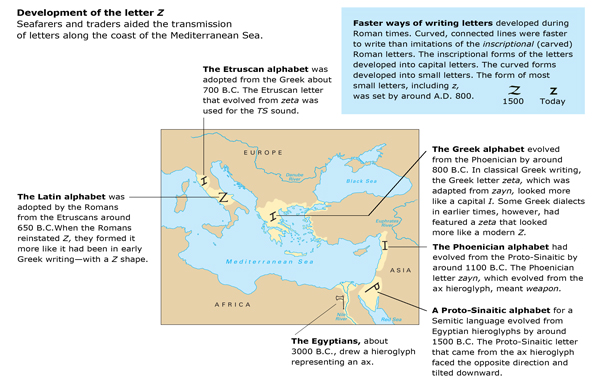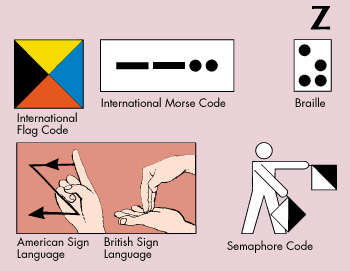Z is the 26th letter of the alphabet used for the modern English language. It is also used in a number of other languages, including French, German, and Spanish. In the United States, the letter Z is called zee, but in Australia, Canada, the United Kingdom, and many other countries, Z is called zed.

The Z sound can be heard in such words as zebra, buzzer, ooze, and fizz. The letter Z can also have a ZH sound, as in azure. See Pronunciation .
Scholars believe the letter Z evolved from an Egyptian hieroglyph (pictorial symbol) that represented an ax. Hieroglyphs were adapted to be used for a Semitic language by around 1500 B.C. The alphabet for this Semitic language—the earliest known alphabet—is called Proto-Sinaitic. By 1100 B.C., an alphabet for the Phoenician language had evolved from the Proto-Sinaitic alphabet. See Semitic languages .
The letter that can be traced to the Egyptian ax hieroglyph is the seventh letter of the Phoenician alphabet, zayn. The Phoenicians used the letter to represent the beginning Z sound of zayn, which was their word for weapon. Around 800 B.C., when the Greeks adapted the Phoenician alphabet, they changed zayn to zeta and continued using it for the Z sound. When the Etruscans borrowed the alphabet from the ancient Greeks about 700 B.C., however, they did not have a Z sound, so they used Z for the sound of TS. By around 650 B.C., when the Romans adopted the alphabet from the Etruscans, Z was not needed for writing Latin. When G was invented, it was given Z’’s place—the seventh place in the alphabet. Some centuries later, when Romans wanted to write Greek words accurately, they brought back Z but added it at the very end of the alphabet.

See also Alphabet .
